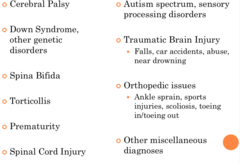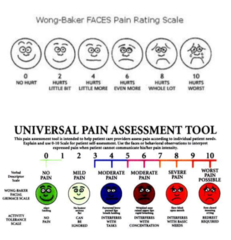A GUIDE TO THE PEDIATRIC PHYSICAL THERAPY EVALUATION – Flashcards
Unlock all answers in this set
Unlock answersquestion
TIPS OF THE TRADE THINGS TO DO BEFORE YOU START YOUR "OFFICIAL" EXAMINATION 4 Main Things:
answer
Open Environment (big room) Essential to establish rapport with patient and family/caregiver (biggest) Early communication with the patient/family/caregiver Efficient and flexible plan O R C F
question
COMMONLY SEEN REFERRAL DIAGNOSES

answer
Commonly seen: -abuse -TBI Can see orthopedics
question
DEVELOPMENTAL DELAY Typically used to describe a child? Could mean?
answer
Typically used to describe a child that is not developing appropriately in *one or more areas* (fine motor, gross motor, etc.) without a known cause Could mean ANYTHING
question
REFERRALSAYS... Walks with a limp Drags left foot Doesn't use right arm Won't sit up Walks on toes Tight muscles 1.) Are any of these diagnoses? 2.) It may be necessary to help family pursue a diagnosis?
answer
1.) No - but turned out to be an in urtero stroke. 2.) we cannot diagnose, but we can mention it.
question
OBSERVATION should be? Part of establishing __________ Can occur during? Allows for the most natural assessment What to observe?
answer
Play based Part of establishing rapport Can occur during caregiver interview Allows for the most natural assessment What to observe -
question
CAREGIVERINTERVIEW 1.) Birth history -explain three questions? 2.) Medical history - 5 questions:
answer
1.) ask questions about birth history -was the child 38 month at birth or 40 months = need to know to find adjusted age = what to expect -any problems during delivery (c-section or vaginal) -birth weight 2.) Medical history Illnesses, including seizure activity, surgery, hospital stays, medications Equipment, if applicable Imaging or other *diagnostic testing* Any *prior history of therapy* or getting therapy anywhere else
question
CAREGIVERINTERVIEW 1.) Development history 2 main things? 2.) Social History -5 main things
answer
1.) Development history When were milestones achieved Growth and feeding 2.) Social History Daily routine, including sleep Home environment Primary caregiver Where does the child spend the majority of the day Educational history, if applicable
question
SYSTEMSREVIEW 1.) Cardiovascular-pulmonary Observation of _________________, monitor as needed Note history of/current use of ______________ 2 other things? 2.) Neurological* State regulation, and 2 other things? 3.) Musculoskeletal* -what to look out for? 4.) Integumentary Scars, skin lesions/rashes, hair patches or excessive hairiness
answer
1.) Cardiovascular-pulmonary Observation of respiratory rate, monitor as needed Note history of/current use of oxygen Heart rate and BP 2.) Neurological* State regulation, eye contact and tracking, shunt 3.) Height, weight, *head circumference/shape*, pain
question
SYSTEMSREVIEW Endocrine system Onset of puberty, if applicable; emotional lability, stature GI - look for?? Reflux, vomiting, constipation, weight gain/loss, tracheostomy, G tube Lymphatic/Immune - ask about? Any swelling, joint pain, general malaise, h/o immunosuppression Genitourinary Bowel/bladder function
answer
GI = look for GI tube. Immune: ask about juvenile RA
question
STANDARDIZED ASSESSMENTS May be ______________, _______________ or used as _________________. Must choose wisely Are frequently becoming a requirement for? Will discuss specific assessments and strategies
answer
May be predictive, diagnostic or used as outcome measures Must choose wisely Are frequently becoming a requirement for insurance purposes Will discuss specific assessments and strategies
question
PAIN 1.) 2 main ways to attain? Over ____ pain assessment tools for infants Common tools are? (3) Ask parent about reports of pain Inquire about pain in age appropriate terms

answer
1.) ask parents or use wong-baker FACES Over 40 pain assessment tools for infants Common tools are 0-10 rating scale, FACES and the universal pain assessment tool Ask parent about reports of pain Inquire about pain in age appropriate terms
question
NEUROLOGIC SYSTEM 1.) 3 main things 2.) 2 other important ones:
answer
Deep Tendon Reflexes -Other reflexes, righting and protective reactions Report of numbness or tingling, report or observation of legs "giving away" Seizure activity Clonus -Unsustained clonus common in newborn and up to a year old Muscle Tone
question
TONE What is tone? How do we describe it? How do we measure it? How do we assess it? -what position? -Observation of? (3) When assessing fir soacticity?
answer
What is tone? -muscle tonicity or flacidity How do we describe it? -hypertonia or hypotonia How do we measure it? (don't memorize -Tardieu Scale -Modified Ashworth Scale (unreliable in kids) -Mild, moderate, severe How do we assess it? -With child lying supine, passive movement of upper and lower extremities -Observation of sitting and standing posture and voluntary movements. assessing for spasticity : move faster (velocity dependent)
question
DYSTONIA Define: Can be _______________ or?
answer
involuntary jerky twisting movements. Can be a diagnosis on its own or a symptom of a neurological disorder
question
RIGIDITY Difference from spasticity? Due to? Incredibly difficult to break/move through range, often stays where placed
answer
RIGIDITY Not velocity dependent Simultaneous contraction of agonist and antagonist muscles Incredibly difficult to break/move through range, often stays where placed
question
seizures 1.) 3 ways of management:
answer
oMedications oSurgery oVagal nerve stimulator -having a seizer = magnet can reset it.
question
HYPOTONIA Define: Often described as: Common in? Thought to be due to? Will see? Children with low tone may "hang" on ligaments, move less, have poor mid range control, difficulties with postural control and balance
answer
Excessively low resistance to passive stretch Often described as "floppy", "mushy" Common in certain diagnoses (e.g. Down Syndrome) Thought to be due to decreased descending outputs Will see excessive ROM Children with low tone may "hang" on ligaments, move less, have poor mid range control, difficulties with postural control and balance
question
why do we need to include muscle tone in exam?? - *objective measures are less effective for kids*
answer
1.) can affect all motions
question
WHY ASSESSING MUSCLE TONE IS IMPORTANT Need to understand for effective? - Not just "is it there" but? Abnormal tone influences (2) what condition has tight adductors?
answer
Need to understand for effective plan of care development - Not just "is it there" but "what is it affecting, if anything?" Abnormal tone influences - active movement such as sitting, standing, running, jumping, etc. - passive range (muscle length) CP
question
MUSCULOSKELETALSYSTEM:RANGEOFMOTION General passive screen of UE/LE range Visual estimation Goniometry if indicated
answer
General passive screen of UE/LE range Visual estimation Goniometry if indicated *Not common*
question
GENERALSCREEN/ESTIMATION Decision making regarding how to assess ROM must be made on a case by case basis Will need to spend more time with more involved cases, such as cerebral palsy, where ROM limitations are generally a significant concern why can it be a problem to do ROM? Starting with a quick screen of passive ROM will help guide you to decide whether to measure As you gain experience, visual estimation will become a useful toolFunctional assessment of ROM during play and standardized testing
answer
Decision making regarding how to assess ROM must be made on a case by case basis Will need to spend more time with more involved cases, such as cerebral palsy, where ROM limitations are generally a significant concern you can get caught up and think it is the restriction motion when it isn't Starting with a quick screen of passive ROM will help guide you to decide whether to measure As you gain experience, visual estimation will become a useful toolFunctional assessment of ROM during play and standardized testing
question
MEASURING Goniometry reliable in? Much less reliable in? _________________ can be appropriate
answer
Goniometry reliable with healthy children Much less reliable in children with pathologies (e.g. cerebral palsy) Special tests can be appropriate
question
Strength 1.) Manual muscle testing Less effective in? 2.) Dynamometry Has been shown to be reliable in some populations, but availability may be limited 3.) what strength is not available for kids??
answer
1.) Manual muscle testing Less effective in young children vs. 12+ 2.) Dynamometry Has been shown to be reliable in some populations, but availability may be limited 3.) Isokinetic machines May not be widely available Systems not designed for children
question
STRENGTH 1.) Assessment of functional skills -4 ways 2.) Portions of standardized assessments In infants, strength is very closely tied to? 3 main things
answer
STRENGTH 1.) Assessment of functional skills To/from squat/stand To/from sit/stand To/from floor/stand To/from walker/wc 2.) Portions of standardized assessments In infants, strength is very closely tied to developmental skills Sit ups, push ups, broad jump
question
BALANCE 1.) May assess during other portions of exam Portions of standardized testing Observe during play, walking and running 2.) Part of caregiver questioning 3.) What is the most common Pediatric Balance Scale (modified from Berg Balance scale)
answer
1.) May assess during other portions of exam Portions of standardized testing Observe during play, walking and running 2.) Part of caregiver questioning 3.) Pediatric balance assessments available Pediatric Balance Scale (modified from Berg Balance scale)
question
OTHER TESTS 1.) TUDS -stands for? 2.) Could be an indicator of? Any pattern acceptable as is? ______ stairs
answer
1.) Timed up and down stairs (TUDS) 2.) Could be an indicator of ability to be active in community and at home Any pattern acceptable as is use of rail or not 14 stairs
question
FITNESS 1.) When/Why assess fitness? - (3) 2.) Under 6 years Assess informally Look for signs of fatigue
answer
1.) When/Why assess fitness?Referrals for obesity Outcome measure for certain patient types If poor endurance is noted as a functional issue 2.) Under 6 years Assess informally Look for signs of fatigue
question
FITNESS 1.) _______________ and over may participate in standardized protocols such as ______________________ 2.) Muscle Power Sprint Test 6 timed 15-m runs then calculate velocity, force, power 3.) 6 minute walk test
answer
1.) 6 years and over may participate in standardized protocols such as Modified Bruce Protocol 2.) Muscle Power Sprint Test 6 timed 15-m runs then calculate velocity, force, power 3.) 6 minute walk test
question
WHEN THE EXAM IS OVER... If you do not feel you have enough information what do we do? Caregivers will want information from you right away what to do to assimilate information?
answer
If you do not feel you have enough information, can complete at another time Caregivers will want information from you right away It is okay to take time to step away to score tests or give yourself time to assimilate information
question
WHENTHEEXAMISOVER... Make recommendations at that time, if able -Regarding? Be cautious with ______________________ - Be judicious about ___________________ or __________________ on the first visit - Referral recommendations
answer
Make recommendations at that time, if able -Regarding frequency of visits, episode of care Be cautious with recommendations - Be judicious about home exercise plan or equipment recommendations on the first visit - Referral recommendations
question
DOCUMENTATION EXAM + ASSESSMENT + PLAN = EVALUATION 1.) Have a template to follow then add/change as needed Make notes on standardized test form Often difficult to document as you go Don't just report scores of tests 2.) Assessment what to put here?
answer
DOCUMENTATION EXAM + ASSESSMENT + PLAN = EVALUATION 1.) Have a template to follow then add/change as needed Make notes on standardized test form Often difficult to document as you go Don't just report scores of tests 2.) Assessment Problem list
question
DOCUMENTATIONEXAM+ASSESSMENT+PLAN=EVALUATION 1.) Write goals last Objective, functional, measurable model still applies Caregiver/patient directed Correlate with impairments found, based on priority given Start with where they are, not where you expect them to be for their age Add modifiers as needed...doing a skill once is not the same as being able to replicate it
answer
Start where they are not where they should be... - write attainable goals based on how they present: quadruped > roll > crawl.
question
COMMON ERRORS IN REPORTS 4 common errors
answer
Being vague Reporting only scores of standardized assessments Failing to assess strength Relating findings to goals



